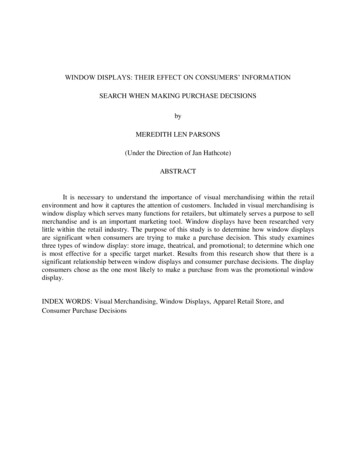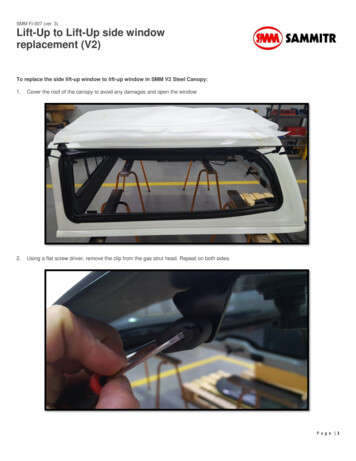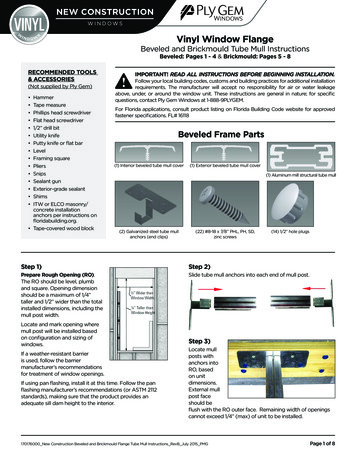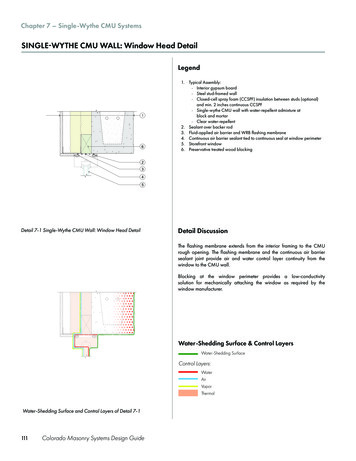
Transcription
WINDOW DISPLAYS: THEIR EFFECT ON CONSUMERS‟ INFORMATIONSEARCH WHEN MAKING PURCHASE DECISIONSbyMEREDITH LEN PARSONS(Under the Direction of Jan Hathcote)ABSTRACTIt is necessary to understand the importance of visual merchandising within the retailenvironment and how it captures the attention of customers. Included in visual merchandising iswindow display which serves many functions for retailers, but ultimately serves a purpose to sellmerchandise and is an important marketing tool. Window displays have been researched verylittle within the retail industry. The purpose of this study is to determine how window displaysare significant when consumers are trying to make a purchase decision. This study examinesthree types of window display: store image, theatrical, and promotional; to determine which oneis most effective for a specific target market. Results from this research show that there is asignificant relationship between window displays and consumer purchase decisions. The displayconsumers chose as the one most likely to make a purchase from was the promotional windowdisplay.INDEX WORDS: Visual Merchandising, Window Displays, Apparel Retail Store, andConsumer Purchase Decisions
WINDOW DISPLAYS: THEIR EFFECT ON CONSUMERS‟ INFORMATIONSEARCH WHEN MAKING PURCHASE DECISIONSbyMEREDITH LEN PARSONSB.B.A. Georgia Southern University, 2008Thesis Submitted to the Graduate Faculty of The University of Georgia in PartialFulfillment of the Requirements for the DegreeMASTER OF SCIENCEATHENS, GEORGIA2010
2010Meredith Len ParsonsAll Rights Reserved
WINDOW DISPLAYS: THEIR EFFECT ON CONSUMERS‟ INFORMATIONSEARCH WHEN MAKING PURCHASE DECISIONSbyMEREDITH LEN PARSONSMajor Professor: Jan HathcoteCommittee: José BlancoYoo-Kyoung SeockMegan LeeElectronic Version Approved:Maureen GrassoDean of the Graduate SchoolThe University of GeorgiaMay 2010
ivDEDICATIONI would like to dedicate my thesis to my parents, my sister, and Chris. I appreciate all of the loveand support you have shown me throughout the past two years while completing my graduatedegree at my dream school. I have never been happier and truly appreciate all the advice I havereceived throughout this process. To Mom and Dad: Without you, I would have never been ableto accomplish everything I have at this stage in my life. I want to thank you for being lovingparents who showed me with hard work, determination, and family support, it is possible toaccomplish lifelong goals. I know it is hard to believe I am finished with graduate school, butthese past two years have been amazing. My experience at the University of Georgia was justwhat I expected and more. To Courtney: I am so lucky to have a supportive sister who I considermy best friend. I appreciate you being there for me the past two years and showing me the wayhere at the University of Georgia. I feel very privileged to have shared the past two years withyou in Athens, and I have learned a lot from you. You are an inspiration in my life, and I am sohappy to share this graduation celebration with you. You have impressed me with youraccomplishments and in a way, pushed me harder and further when it comes to my personalgoals. I want to thank you for being so supportive and loving. To Chris: I appreciate your supportthe past year while completing my Master‟s degree. You have always believed in me and havealways been there for me. I love you and want you to know how thankful I am to have someoneso special in my life. Thank you for everything you have helped me accomplish. I have learned agreat deal about life from you the past year and look forward to our future.
vACKNOWLEDGEMENTSI would like to thank Dr. Jan Hathcote, my major professor, for all of her assistance andcontribution the past two years while working on my thesis. I appreciate all of the hard work,time commitment, and patience she has shown towards me the past two years. I have learned somuch from her and respect her research techniques. All of the countless hours of meeting todiscuss my thesis have paid off and I could have never achieved this result without herexperience in academia and knowledge about research in the retail industry. Thank you again foreverything.I would also like to thank my committee members: Dr. José Blanco, Dr. Yoo-KyoungSeock, and Dr. Megan Lee. Your experience within research was much appreciated, along withall of the personal assistance throughout the process of writing. José, your knowledge aboutvisual merchandising and theatrical window display was appreciated and extremely helpful. Dr.Seock, I appreciate you taking time to help me with my survey and the results of my researchquestions. Megan, I appreciate you taking time to work with me and helping me contact localretailers. Your input as a non-merchandising individual helped my writing process transition alittle smoother. Thank you to everyone in the Textiles, Merchandising, and Interiors departmentwho helped me through my Master‟s process. I appreciate everything the faculty and staff did tomake my experience enjoyable and I feel privileged to have worked with so many talentedindividuals within our college. I would also like to thank the local boutique owners/managers ofFlirt, Fetish, and Pitaya who allowed me to photograph their window displays and use them inmy survey.
viTABLE OF CONTENTSPageACKNOWLEDGEMENTS . vLIST OF TABLES . viiiLIST OF FIGURES . ixCHAPTER1 INTRODUCTION . . 1Justification .4Purpose 4Objectives .4Research Questions .5Conceptual Definitions .52 REVIEW OF LITERATURE .7Window Display .8Target Markets .18Theoretical Framework .19Research Questions .253 METHODOLOGY . 26Operational Definitions .26Description of Sample .27Description of Survey .27Data Collection . . . 29
vii4 RESULTS . . 31Description of Respondents . . 31Data Analysis . . 33Discussion . . 375 CONCLUSION 42Limitations . 44Future Research . . . 45REFERENCES . . 47APPENDICES . 50ACOPY OF BUSINESS CARD . . 50BINFORMED CONSENT FORM . . 51CCOPY OF ONLINE SURVEY . . 52DPHOTOGRAPHS FROM FOCUS GROUP . . 57ETHREE PHOTOGRAPHS SELECTED FOR SURVEY BY FOCUS GROUP 59FSURVEY QUESTIONS . . . . . 60GDOWNTOWN RETAIL OWNER/MANAGER LETTER . . 61
viiiLIST OF TABLESPageTable 4.1: Demographic Information from Window Display Survey . 32Table 4.2: Correlation Between Window Displays and Purchase Decisions . . 34Table 4.3: Correlations Between Each Type of Window Display and Purchase Decisions 35Table 4.4: Correlation Between Age Category 1 and Age Category Purchase Decisions andWindow Displays . 37
ixLIST OF FIGURESPageFigure 2.1: Store Image Window Display Example 11Figure 2.2: Theatrical Window Display Example . 13Figure 2.3: Promotional Window Display Example . 16Figure 2.4: The Consumer Buying Decision Process Model: The Five Stage Model . 19Figure 2.5: Research Question Model . . . 25
1CHAPTER 1INTRODUCTIONVisual merchandising today has become more complicated as competition betweenretailers continues. Creativity plays a major role, and consumer purchase decisions areinfluenced by retailers‟ marketing strategies. Visual merchandising, defined according to RetailProduct Management by Rosemary Varley, is a common term for how retailers‟ present theirproducts or merchandise to the best of their ability and the merchandise is displayed “to its bestadvantage” (Varley, 2001, p.182). Visual merchandising also “allow[s] retailers to make themarketplace innovative, exciting and stimulating by creating product-led stories supported bymerchandising solutions” (Varley, 2001, p.183). Varley describes details about areas that areincluded in visual merchandising and the duties performed by visual merchandisers. These tasksinclude “choice of fixtures and fittings to be used, method of product presentation, constructionof „off-shelf‟ displays, choice of store layout, use of point of sale material to encourage impulsepurchases, and construction of window displays” (Varley, 2001, p. 183). As a visualmerchandiser or designer, it is crucial to have knowledge about the retail industry, some businesssense, understanding of the fashion industry, and creative ideas. It is also necessary to understandthe importance of visual merchandising within the retail environment and capture the attention ofcustomers. One of the many elements included in visual merchandising is window displays.Window displays serve many functions for retailers including displaying the merchandise whilecreating and maintaining a store image. In addition, window displays exhibit a specific
2theme or are used to entertain customers, but ultimately serve a purpose to sell the merchandise.A final function that window displays serve includes their promotional ability for events withinthe store. Martin Pegler (1998) states “the primary purposes of displays are to present and topromote” (p. 44). According to Varley (2001), window displays make a vast contribution to theexternal design of stores and have traditionally been an important function of visualmerchandising. These two authors of retail and visual merchandising books are consistent withthis study and the importance of window displays for retailers.According to Davis (2002), “the American "department store" was birthed between 1860and 1910” (para. 1). The art of visual merchandising has been around for many years, but the“the art of the store window was not part of the American psyche until the department storesexisted” (Davis, 2002, para.2). The huge store fronts that we know today came into existenceafter the invention of plate glass, allowing window displays to become useful for retail stores(Who created the first mannequin, 1999). Store window displays and early mannequins firstbegan at the turn of the twentieth century, and were initially displayed in retail store windowsduring this time. Words used to describe window displays include window trimming, display,and visual merchandising (Davis, 2002). According to the article Early Store Retail Windows,1920s window design was called “display,” and people in this time period called the designers“Display Man” (Davis, 2002), due to the fact that the weight of the mannequins permitted onlymen to move them.Window designers or window dressers, as they are sometimes called, are influential withtheir designs and display the merchandise in retail stores in creative ways based on theirexperience to encourage multiple sales of apparel and accessories. Some of the most famouswindow dressers or designers include artist and designer Andy Warhol, Gene Moore from
3Tiffany‟s, and Simon Doonan from Barneys New York. Past and present window dressers showmerchandise in a variety of ways, but the primary forms include windows for theatrical andcreative purposes, promotional windows, and store image windows. Simon Doonan, previouswindow dresser for Barneys New York and one of the most influential and modern windowdressers, is known for his creative and extreme displays in New York. He says that “windowdressers specifically deal with the creation of the desire to shop” (Doonan, 1998, p. 8). Doonan(1998) also states that store windows are the advertising venue with the closest proximity to “thepoint of sale,” and windows are retail‟s oldest form of advertising (p. 8). Thus, it is importantthat window dressers maintain the overall store or brand image. According to Doonan (1998),there are short term and long term goals for window designers. “The short term goal of windowdressing is a quick sale,” selling the clothing or accessories on the mannequin in a specificwindow, and “the long term goal is the creation of a store image” (Doonan, 1998, p. 8). Someretailers allow their designers freedom to use their creativity within their designs due to thedesigner‟s reputation, or if the store is looking for a new image, they may think the designer willhelp the retailer create this image. Today, visual merchandisers are learning to accept budget cutsin order to continue showing their creative window displays. Display, according to Pegler, ischanging and not dying, but display persons must continue to work hard to bring entertainmentinto the retail store through displays (Pegler, 1998). Most people in developed areas in the worldunderstand the importance of the mannequin within window displays and therefore understandthe importance of window designers‟ jobs within retail stores even though display is changing.
4Justification.Due to the lack of research on visual merchandising, and more specifically windowdisplays, this research will help retailers with one of the most essential marketing tools designedto support their sales. Due to the difficulty in collecting and analyzing data for the creativityelements, there is little research and lack of literature in this area.Purpose.The purpose of this study is to determine window display influence on customers makingpurchase decisions, while also assisting smaller, downtown retailers with their sales potentialthrough window display. The framework for the study will focus on the consumer decisionprocess model, also known as the purchase decision model, to determine if the target market ismaking purchase decisions based on these displays. It is important to identify which type ofwindow display will influence consumers when making purchases and verify the retailers‟ targetmarket to ensure they are reaching this market.Objectives.The main objectives of the study include: 1) provide empirical data to small retailers forstand-alone stores, similar to boutiques, in a downtown college town, 2) make a contribution toretailing research by investigating the impact of visual merchandising, and 3) look at the impactof window display on consumer purchase decisions.
5Research Questions.Q1: Do window displays positively influence customers‟ purchase decisions?Q2: Are consumers‟ purchase decisions influenced by store image, theatrical, and promotionalwindow displays?Q3: Does a specific type of window (store image, theatrical, or promotional) influence consumerpurchase decisions?Q4: Is there a significant difference between the younger age group (18-21 year olds) and olderage group (22-25 year olds) when utilizing window displays to make purchase decisions?Conceptual Definitions.1. Creative (Creativity)- “marked by the ability or power to create; having the quality �(www.merriam-webster.com/dictionary/creative).2. Merchandising- “promoting the sale of certain commodities” (Bell & Ternus, 2002, p. 18)3. Off shelf displays- “displays designed to have additional impact by showing the product as itmight be used alongside other products to suggest complementary purchases. This type ofdisplay can also be considered to be a visual feature that creates interest or excitement within theretail outlet. Many off-shelf displays are not used in the routine selling process and therefore canbe constructed to make a significant visual impact” (Varley, 2001, p. 191)4. Point of Sale (Also known as Point of Purchase)- A type of display usually “synonymous withimpulse shopping,” but can be displays, fixtures, or items provided by vendors or manufacturersused to sell their products. These displays help “a) attract attention to the product, b) promote orreinforce brand name recognition, c) show and explain the product to educate the consumer,
6d) answer relevant questions: price, size, applications, e) hold stock or arrange stock for shopperconvenience, f) increase sales by coordinating items- or by “impulse sales” (Pegler, 1998, p. 294295)5. Promotional windows- “feature products that are part of an advertising strategy promoting anentire line of goods, a single item, or a special storewide event” (Bell & Ternus, 2002).6. Store Image windows- “the way a store is positioned in a consumer‟s mind, including thereinforcement of a retail brand and what it stands for” (Varley, 2001, p. 173).7. Theatrical windows- once limited to Christmas displays, now boost retail sales along with fiveother items which include: “1) make your store stand out from the rest, 2) appeal to thecustomer‟s “inner child”, 3) create a romance that surrounds your products and enhances theirdesirability, 4) make a joyous shopping experience, and 5) create a buzz” (Davis, 2009).8. Visual- “relates to images that are taken into the brain by way of the eye” (Bell & Ternus,2002, p. 18)9. Visual Merchandising- “the process of promoting the sale of products by producing mentalimages that urge potential customers to make purchases” (Bell & Ternus, 2002, p. 18)10. Window displays- “have an important role to play in communicating to the potentialcustomer what the retailer stands for, and make customers aware of the type of merchandisebeing sold, and hopefully will attract the interest of target customers.” Window displays can beopen, backed, or partial boarding depending on the retailer‟s preference (Varley, 2001, p. 196)
7CHAPTER 2REVIEW OF LITERATUREVisual merchandising, according to Bell and Ternus (2002), can be defined as “theprocess of promoting the sale of products by producing mental images that urge potentialcustomers to make purchases,” (p. 18) but merchandising is also a retailer‟s creative way ofdisplaying its merchandise to build a store image and attract its target market. Bell & Ternus(2002) also stated that “effective visual merchandising techniques establish and maintain thestore‟s physical and mental image in the customer‟s mind, providing support for the rest of thestore‟s selling effort” (p. 18). Effective merchandising is no longer about making themerchandise look presentable in a store or window display, but more about the “actual selling ofmerchandise through a visual medium” (Pegler, 1998). Set up of displays within the windowand within the store is important, along with the set up of mannequins, furniture, racks,merchandise, and signage. These are all areas of visual merchandising and should flow togetherto impact consumers‟ purchase decisions. Window display is the main focus for this research, butother areas of interest for this study include consumer reaction toward different types of windowdisplays and the effectiveness of these displays to benefit smaller retailer stores. The elementschosen to measure effectiveness for retailers include types of window display: windows with thepurpose of portraying the store image, theatrical windows, and promotional windows. It isnecessary to examine the target market and determine the effect of each type of window on it, ifat all. It is also necessary to verify these retailers‟ target market and assist with effectivelyreaching these markets.
8Window Display.Window display is one of the most important aspects of retailer store image, brandawareness, advertising, as well as a key communication variable to show consumers who theretailers are targeting. Display is a form of advertising for the retail store whether it is duringnormal store hours or after dark with bright lights illuminating the window for people passing togaze in. Window displays are “not only an integral element of both its ambient and designenvironment, but are also typically encountered before most, if not all, other elements of theretail environment (Klokis, 1986, p. 108-109). According to the Visual Standard 1 from ClubMonaco, the top ten visual basics list windows as number one. This includes window cleanliness,steaming of the merchandise, mannequin placement, styling of mannequin‟s clothing andmerchandise for the store, along with the lighting within the window, and window background.The background in this study describes the color choice painted as the backdrop, whether ablown up photograph is used as the backdrop for the window, or merely having aestheticallypleasing props hanging in the background. The other nine items ranked from Visual Standard 1for retail environments are as follows in order: interior mannequins and display, merchandising,fixture placement, lighting, store atmosphere, staff, fitting rooms, cash desk, and stockroom(Club Monaco Visual Standard 1, n.d.). Window displays are also “likely to provide consumerswith important cues about a store‟s overall image” (Sen, Block, & Chandran, 2002). Store imagewill be discussed later as an important element of an effective window display type. Theresearcher has found through interviews that customers respond more positively to display withmannequins than to other visual displays without a mannequin. Findings within a previous studytitled Visual Merchandising and the Creation of Discernible Retail Brands the focus is on the
9importance of visual merchandising and the lack of research in this area (Kerfoot, Davies, &Ward, 2003). Within Kerfoot, Davies, & Ward‟s (2003) study, “mannequins generated a positiveresponse” and “respondents expressed approval at being able to see designs, entire outfits, andsee what the clothes will look like on” (p. 149). It has also been found that when it comes towindow displays and consumer shopping decisions, consumers are more likely to purchase froma display if they can imagine what the clothing will look like on them personally (Sen et al.,2002). Within this previous study, consumers participated in surveys and answered questionsabout items associated with window displays to determine their effectiveness, but one of theimportant factors within this study was the “FIT” factor, a four item measure that “assesses theextent to which consumers look at window displays to better visualize how the displayed clotheswould look on them and infer the degree of product fit” (Sen et al., 2002). The four item measureincludes questions asked in the survey and are listed as follows:a) Looking at window displays makes it easier for me to decide whether I would lookgood or not in the styles displayed.b) I find window displays useful for visualizing how the clothes would look on me.c) I usually look at window displays to imagine what the clothes would look like on me.d) I find it easier to visualize how clothes will look on me by looking at window displays.(Sen et al., 2002, p. 288).Findings from Sen et al. (2002), determined that the FIT variable had the highest significance forconsumers to enter a store based on its window display, and also FIT was one of the top threemost significant variables for consumers to purchase from a display (Sen et al., 2002).
10Mannequins in a window or free standing are valuable tools to help customers visualize howclothing will look on them, and previous research by Kerfoot, Davies, and Ward (2003),describes consumers‟ responses towards mannequins. The study stated that respondents likedbeing able to “see designs, see the entire outfits, and see what the clothes will look like on”(Kerfoot et al., 2003, p. 149). Respondents also noticed when mannequins were not used withindisplays and reacted negatively towards these displays. Consumer‟s reaction toward otherdisplay forms has been tested, whether the reaction was positive or negative, but not expandedupon to see why consumers prefer mannequins over the other forms (Kerfoot et al, 2003).Within this study, three types of window displays will be researched to determine theeffectiveness of each type in influencing consumer‟s in making a purchase. This study willexamine three types: store image, theatrical, and promotional window displays. An example ofeach type is shown in the following pages with a short description and a photograph fromFairchild Publishers will further explain its classification.
11Store Image Window Display.Figure 2.1: Store Image Window Display ExampleBased on the caption under the photograph, it is explained that “you must know your customer” and theluxury factor in this display is said to be “right on target for this store‟s smart and sophisticated shoppers”(Pegler, 2006). This statement illustrates this window is meant to show a specific image which people thatshop at Bloomingdale‟s have or the image they are thought by the designers to have. This photograph wasused with the permission of Fairchild Publishers Inc.The first type of window display significant to this study is store image display whichincludes how the retailer wants to be perceived by customers. Atmosphere has to do with how
12people react within retail environments, meaning if the atmosphere is enjoyable consumers willshop longer and this is important for store image as well. According to Kotler‟s articleAtmospherics as a Marketing Tool, the “quality of the surroundings” known as the storeatmosphere has been studied and proved important in many settings, but most importantly in abusiness sale setting where “buyers respond to a total product” (Kotler, 1973, 1974, p. 48). Thetotal product can be tangible, or an intangible example, like a service. Kotler (1973,1974)describes in detail the different dimensions associated with surroundings, but the only one ofinterest to this study is visual dimensions within an atmosphere. The visual dimensions include“color, brightness, size, and shapes,” which are all important elements of a window display(Kotler, 1973,1974, p. 51). The other three areas of dimensions are for the retail storeenvironment or store atmosphere and as mentioned do not pertain to this research on visualmerchandising. However, store atmosphere along with store image or how the store is perceivedby consumers are both important. It is stated in previous research that “consumers are likely torecall various aspects of the image rather than the environmental cues that give rise to theseaspects” (Mazursky & Jacoby, 1986, p.146 ). This statement means that consumers are likely topay attention to images rather than things going on around them at the time. The environmentalcues mentioned here may be described as things going on around consumers when trying tomake a purchase decision or while visiting a retail environment. This statement reaffirms theimportance of image when it comes to using it in the context of window displays. It explains howimportant it is to carefully select merchandise for a display to portray the image retailers want fortheir store, and the merchandise they sell. If appeal to high-end customers is desired, they need tofocus on offering window displays with high-end merchandise.
13Theatrical Window Display.Figure 2.2: Theatrical Window Display ExampleThis photograph is an example of a theatrical window based on the elements that there are many propsused within this display, the mannequins are not in a normal upright position, and the lighting is aspotlight not an overhead light or window light. This window shows a dramatic scene. This specificwindow display is not just trying to show clothing displayed, it is clearly trying to capture the consumer‟sattention and entertain (Pegler, 2006). This photograph was used with the permission of FairchildPublishers Inc.
14Theatrical windows, the second type of window display chosen for this study, are mostbeneficial for retailers to entertain and lure their target market to enter their store. Imaginationplays a large role when it comes to retailer‟s creating entertaining windows and “creativity is avery important component of advertising” according to an article by Till and Baack (2005), sothis is helpful when observing originality within window display. As we know, window displaysare a form of advertising for the retailer, and it is thought that theatrical windows are effectiveways to advertise based on their creativity.Theatrical window displays share elements from theater production such as elaborate setdesigns, lighting effects, props other than mannequins, and even sound effects and multimedia (J.Blanco, personal communication, January 20, 2010). Within theatrical windows, componentsthat may have an influence on whether people make purchase decisions from these windows mayinclude backdrops, lighting, use of props more than mannequins, and set up of the display. Themerchandise must also be displayed in a unique way to be considered creative or entertaining.According to a recent article in Display and Design Ideas Magazine, there are fivereasons theatricality will boost retail sales. Davis (2009) states that “the marriage of retail andfantasy is not new,” (p. 17) but it usually surrounds holiday windows in New York. Davis tries toencourage retailers to use these types of windows and displays to “differentiate themselves fromother retailers while also appealing to the customer, creating romance to surround products,make an enjoyable shopping experience, and create a must-see store” (p. 17). Another suggestionfrom the article is to make well displayed merchandise appear to make a specific customer feel acertain way. The creativity behind the displayed merchandise encourages sales and evenencourages customers to spread information about the retail store to other consumers.
15Theatrical window display is not an area that has been researched, and therefore verylittle literature is available. The few articles on this topic
Visual merchandising also "allow[s] retailers to make the marketplace innovative, exciting and stimulating by creating product-led stories supported by merchandising solutions" (Varley, 2001, p.183). Varley describes details about areas that are included in visual merchandising and the duties performed by visual merchandisers. These tasks











